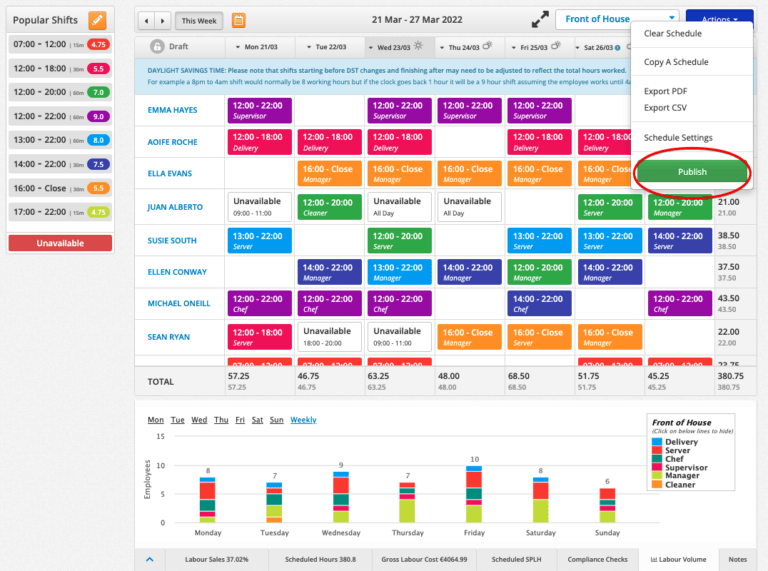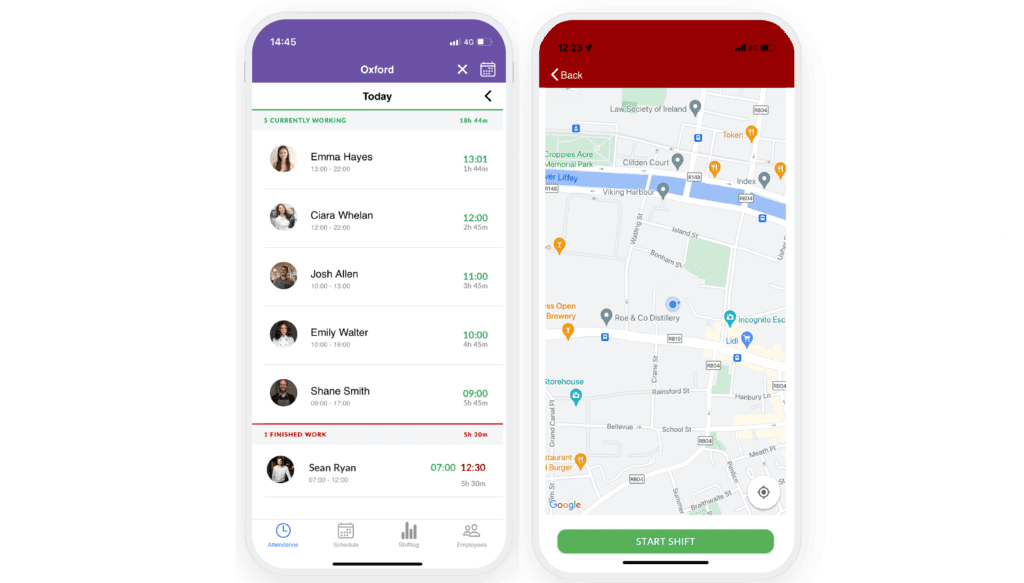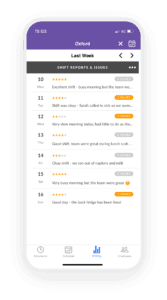YOUR GUIDE TO BETTER SCHEDULING
Ultimate Guide to Hospitality Scheduling
Schedule a free Consultation
Rota software built to make management, scheduling and time tracking of hospitality workers easier.
To begin, what is a Schedule?
Schedules are designed to aid businesses to run as efficiently as possible; ensuring they have the right amount of experienced staff to willingly align with the businesses’ goals and objectives.
There are a variety of work schedules and they vary on the type of industry of which you are in as well as the season you’re entering. It’s common that if your business operates over a certain length of time, this is when you focus on shift based scheduling. Not to worry, we will be looking more into the different types of scheduling further into this guide.
How long should it take to me to create the weekly work schedule?
Well if you’re here, I’m thinking it is taking you longer than it should! Other business tasks often get in the way and with payroll or HR tasks to be done, putting together the weekly schedule is the last thing you want to do. I don’t blame you, with time-off requests, staff falling sick and employees not showing up, it can all start to get a little messy!
Why is Scheduling important?
Scheduling with Bizimply enables you to make more informed business decisions knowing that you are fully compliant with any regulatory, legal, or contractual obligations.
You can gain complete control over all your scheduling requirements; shift patterns, ad-hoc shifts, or even volume-based scheduling. Let’s explore why:
TIP: Test if you’re spending too long creating schedules – for an entire week, track the time you spend building and managing your team schedule; also factor in changes that have to be made once published, it all uses up valuable time.

7 Things Employers Must Do For Better Scheduling
1. Reduce time waste
Using a cumulative scheduling system, allows you to avoid wasting employees’ time by scheduling them when they are not required for that shift or are unavailable. You’ll be able to respond to any changes and shift swaps more easily and in a faster time, and you’ll always have insight to real time data.
2. Visibility
As your business grows, it becomes more difficult for managers to know who is on site and what responsibilities they are carrying out for that shift. Especially now, people may no longer be working in the same physical location, or they could be working remotely.
Reduced visibility can affect productivity of employees, customer service and costs. You could be paying for people who are absent and incurring unnecessary overtime costs.
3. Get real time data
Get those numbers working. Determine your labour costs through a labour budget tool and/or POS system integration and use past and projected sales to keep your costs under control.
Analyse your footfall; have you noticed the previous three Wednesdays earnings are higher due to a reoccurring gathering? It is important to consider staffing up to cover these busier periods.

4. Schedule for the future with projected sales information
Know your business, down to the nitty gritty. As you accurately predict scheduling needs, your schedules get smarter. This minimises scheduling errors, meaning you can increase engagement and strengthen morale.
You may not realise it, but these factors do matter, consider the difference that a single-percent can make.
32% of UK hospitality employees admitted they would like more transparency from employers regarding shifts / scheduling.
(YouGov, 2019)
Getting the balance right!
The key to saving money is making the routine of scheduling staff, and subsequently tweaking schedules, easy and intuitive. This helps ensure you and your managers get the visibility of what is going on in your business. This then leads to an understanding (the strategic), so you can make smart decisions on your schedule.
The trick is to deploy as few staff as possible, and as many as are necessary. It is quite a tough balancing act. Do labour patterns match sales patterns? It is worth taking time to identify the reasons why things go quiet. Businesses that do a lot of lunchtime takeaway business for office staff may, for example, find that things are quieter on a Friday, perhaps because customers leave early for the weekend, or go for a sit-down meal with colleagues?
Restaurants and retailers have always tried to control the cost of staffing, even more so in recent years. So it is not uncommon for our managers to be scheduling with a target number of hours and/or a target wage and salary base to consider. This can lead to a frustrating experience when scheduling as we constantly check if we have gone over budget, or ask what does each decision mean.
How to get the most out of your scheduling
Proactive Scheduling
Fail to prepare, prepare to fail.
As a business owner you should always be planning and looking forward when it comes to scheduling, a proactive approach means you can handle any issues that may suddenly arise for example; staff absenteeism, you want to manage problems in the most efficient and professional way. At Bizimply we are all about having the right people in the right place at the right time.
Automated scheduling
Organisations who implement automated scheduling systems are more than twice as likely as organisations without automated scheduling to provide self-service access to employees. This is an important factor in improving employee engagement and also contributes to schedule accuracy.
These organisations are also more than four times more likely to use dashboard tools that can share workforce management data with managers. The Bizimply workforce and labour data dashboards help managers gain insight into the business performance and can understand how the labour budget is spent, in turn this data can be used to help with future labour forecasting.
Control labour spend with effective scheduling
Scheduling software like Bizimply makes it easier for you to build accurate schedules that ensure you have the right amount of staff available and can cover anticipated demand. That way, you can minimise having extra staff scheduled, stop being over reliant on contract workers, and decrease overtime pay which can be the reason your labour costs can be too high.

Measure schedule effectiveness to drive improvements
With the opportunity to pull Reports on Bizimply, it simplifies your scheduling process even more. You have the ability to review previous schedules, measure how effective they were and use this information to enhance the next schedule you create. You can also pinpoint areas where you overspent by examining available budgets versus actual report data. With the scheduled SPLH and Gross Labour costs features, it gives you even deeper insight into these costs as you build your schedule. Amazing right?!
5 benefits you will see with improved Scheduling
1. Time
No matter what type of business you’re in, labour scheduling can be a time-consuming, error-prone, and downright frustrating task.
You need to match employee skill sets, availability, and preferences with fluctuating business demand in order to maximise productivity and minimise costs. Trying to schedule a workforce using spreadsheets and semi-automated systems too often results in less-than optimal performance, overstaffed shifts or undermanned rushes.
Using a cloud based software like Bizimply to build, fill, manage, and measure best fit schedules enable you to meet business goals, all without overspending labour budgets!
2. Better communication with staff
Poor staff scheduling can have major consequences for always-on operations, even if it doesn’t look like it on the surface.
It would be worth implementing an ongoing formal process to review costs, compliance, and other key factors, especially for larger stakes. Publish and communicate the schedule with your employees so that everyone knows where and when to find it.
Online scheduling solutions ensure everyone will have access to their schedules anytime and anywhere and they’ll be notified of any changes via the communication methods used.


3. Costs
Optimising schedule costs can help to reduce your spend on overtime and ensure you always have the minimum staffing levels in place to meet forecasted demand.
This limits overstaffing and contributes to operating within your budgeted labour costs. However, if peak hours aren’t taken into consideration, performance will be affected and customer demand won’t always be met.

4. Performance & Productivity
Are all hands on deck at your busiest times?
There should never be anyone taking their break or working in the office in the middle of service. At peak times, not only are staff on breaks limiting the service you provide to your customers, but they are increasing the pressure on the staff that are working.
Hospitality jobs have some of the highest turnover rates in the industry.
(Harver, 2019)
9 ways to cut costs when creating your Schedule
1. New week, New schedule
Every week is different and your schedule should reflect this. Don’t just recycle last weeks schedule. Ensure you have checked the availability of your staff for the coming week.
Check last weeks schedule to see where you may have been overstaffed and look ahead to any large events that may be planned. Don’t leave yourself struggling to cover shifts at the last minute.
2. Cost & build
Bizimply allows you to cost as you build which is great to see where you can save. If you wait until the end then it becomes a mad dash to cut hours and stay on budget, which always leads to inefficient schedules.
3. Set clear targets
Without clear targets there is no way to ensure a steady labour cost. Work out what your current target labour cost is based on this weeks schedule and see if you can reduce it by 5% for next week.
4. Monitor targets
Target sales per labour hour (SPLH) is a great key performance indicator (KPI) to track for your business. If you have target sales of £2000 and target hours of 40 then your SPLH is £50. Try and maintain a steady SPLH throughout the week and don’t let it fluctuate with sales patterns. This will also ensure you have adequate staff cover for each day.

5. Arriving together?
Do all your staff arrive at the same time for each scheduled shift? Do you need all your staff to be in at the same time? Most shifts require a bit of prep work which usually only takes one or two people. If you adjust your shifts to start in 15 or 30 minute increments then your staff will arrive as you need them.
6. Are labour patterns reflecting sales?
When your sales increase your labour cost may increase but when sales decrease do your labour costs decrease? In order to achieve a reduction in costs you have to schedule accordingly and anticipate periods of low sales as well as high sales.
7. Be Flexible
Rarely do shift workers have control of their schedules. This can have a huge impact on their lives, making it hard for them to plan outside of work. For part-time workers, hourly workers, the deskless workforce, or people working in the gig economy, this also increases the challenge of working multiple jobs and calculating their income, as their hours can fluctuate wildly.


8. KPI’s
Help your managers to perform better and achieve your organisation’s standards using a wide range of configurable KPIs embedded with the schedule. Assess and analyse each location against the same set of KPIs or define location-specific measurables.
9. Overtime
Set realistic overtime goals with your team.
While it might be unreasonable to shoot for no overtime, a 25% reduction might be more doable. Help your team reach these goals by showing them alternative solutions to using overtime that will save you money. A lot of restaurant back-office systems offer an “approaching overtime report” which can help you control hours and avoid overtime. Use these tools to help reach your goal.
Optimising the Schedule
The right data, the right people, the right tools
Optimising labour costs is best managed from the top down with an investment in technology that enables operators. When companies invest in the right technology to measure incoming data, success will follow when used right. Best practices can be more easily shared across multiple locations when there is a deeper insight into data available. If one location consistently reaches and manages labour targets whilst other locations underperform that can be leveraged.
Full visibility and ownership to employees
Having engaged and empowered staff who strive to perform; achieving goals and objectives are an advance for any hospitality brand.
Expressing a strong connection between performance and results as expressed in the data is vital to meeting that goal. It enhances the value of labour against its rising costs, which is an important facet of ROI.
What do your employees want from a Schedule?
Certainty
Employees want to be able to plan their lives for more than a few days in advance. They want to be able to rely on their managers and be reassured they won’t be messed around and can count on the schedule accuracy first time round. This avoids employees making unnecessary journeys to work or getting annoyed if there has been a mix up of shifts – especially without being notified.
Stability
The majority of staff only have one job and strongly rely wages of that job. Therefore, they want their hours to be guaranteed and roughly the same every week to help them manage their money effectively. They prefer it when managers base the rota on a set pattern, so they can be reasonably certainof their hours before the rota has even been published. If managers drastically change staff hours from week to week, you’ll get some angry and upset employees.
Mobile Compatibility
Mobile-first WFM solutions will be co-assisted with an app that needs to be manageable and as simple as other apps they may use on the daily. Taking this approach allows you to get into more detail that you may not have considered before – peak times, management level on each shift, number of employees needed for each time slot; in turn, this drives sales. These are the kind of results we want to deliver on and lead to a happier workplace overall.
Notified of changes
Every time there’s a change to the rota, employees want to be made aware of these changes; especially if it involves them. Whether this is change of starting time, swapping shifts with another employee or even last minute emergencies of needing to close.
An effective communication system must be in place to prevent rota communication problems and confusions.

Shift run-down
Employees always like to have a rough idea of what they are going to walk into when they arrive to work. Yes, the majority of shifts will be the same responsibilities and roles but even finer details of who is opening or closing the store for that day, whether they have larger parties in or perhaps if they are on a training course that day. Providing a brief outline of what to expect can prepare your employees in the best way for their shift.
Download your Copy
Download a PDF of the Ultimate Guide to Hospitality Scheduling to share with your team.





